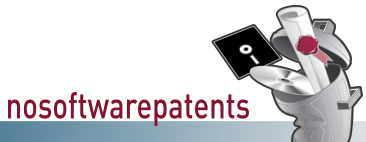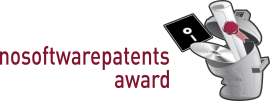| English | Deutsch |

![- Logo]](../images/layout007-small.png)
| Home |
| Software Patent of the year 2006 |
| About |
| Supporters |
| Background |
| News |
| Press November |
| Links |
| Contact |
| Imprint |
September – Patent 5
- EU-Patent on software (algorithm / mathematical formula)
- Application to the European Patent Office on 20/2/2002 by Nippon Telegraph and Telephone Corporation (Japan)
- Granted on 26/4/2006
- Date of priority: 22/2/2001 (valid no more than until 22/2/2021)
- Patent attorney: Urquhart-Dykes & Lord LLP
- Patent specification provided by FFII/Gauss
- Patent specification provided by EPO/espacenet
- The decisive element are the claims, as they specify which actions are forbidden within the framework of the patent.
- Violating one single claim is sufficient to be considered a patent violation. Generally, claim number 1 is the decisive main claim which covers all other claims relating to special cases.
- The description is intended to help the reader interpret the claim. At the same time, it is supposed to document and disclose the details of the invention. This disclosure is the original purpose of the entire patent system.
- In practice, a patent specification contains no detailed information on how the patented procedure could be implemented (even if the patent owner allowed the implementation). In particular, a software patent contains no program code (reference implementation), but merely describes the idea of a software.
Patented idea: On the basis of the verification results per groups of digital partial signatures is decided whether (a) none, (b) one or (c) two or several partial signatures are false.
Main claim: The main claim describes in a very complicated way, on a whole DIN-A4 page, the following stages:
- Numbering of the partial signatures from 1 to m.
- Forming of groups out of k signatures: 1 to k, 2 to k + 1, 3 to k + 2, etc. (when one exceeds m, one starts again from 1)
- Verification of signature for each group.
- On the basis of the results of the group verification (in the clear modality – see Everyday parallel) to determine if (a) none, (b) one or (c) two or several partial signatures are false.
Further claims:
- A document with one such signature.
- Apparatus (for ex. PC with software) which generates and verifies such signatures.
- Device which signs documents.
- PC software which generates and verifies such signatures.
- Data carrier on which there is the PC software.
Beschreibung: The patent specifications mention first of all – already existing – methods to distribute the secret key which is necessary for a digital signature to several locations, in order not to lose the whole key in case of the failure of a partial key. The finding is described that the verification of a signature distributed in this way wastes the CPU time in case of many partial signatures, whereas it is reasonable to verify them per groups (nevertheless at most k partial keys).
The patented "finding" is exclusively the last stage, namely the determination of the number false signatures out of the group signatures.
Alltagsparallele: Exercise: 9 weights ("signatures") are provided with the imprint "10 grams". It appears the suspicion that a part of the weights should be too light in reality. In order to find this out, we weigh the weight on a balance which can be used easily and which can indicate only "correct" or "wrong". Unfortunately, the balance is not calibrated for 10 grams, but for 30 grams. How do we find out if (a) all the weights are correct, (b) only 1 weight is wrong or (c) 2 or several weights are wrong?
Solution which infringes the patent: We weigh always 3 weights together. If it is always indicated "correct" the answer is (a). Otherwise, we verify if there was on the balance a certain weight when it was indicated "wrong". If the case is so, the answer is (b), otherwise (c).
Examples for patent infringements:
- The patent specifications do not specify anywhere that there has to be more than a partial signature. In this respect, any software for the verification of digital signatures infringes the patent.
- To perform a calculation per groups which is otherwise too complex and then to continue the calculation with the groups is a standard modality in informatics. Without the limitation to the distributed digital signatures many scientific software programs would infringe the patent . Although this patent does not extend to the distributed digital signature itself, one can derive from it that any software for distributed digital signatures infringes it.
| Previous Software Patents of the Month |
| > September |
| Patent 1 | |
| Patent 2 | |
| Patent 3 | |
| Patent 4 | |
| Patent 5 |
| > August |
| > July |
| > June |
| > May |
| > April |
| > March |
| Press Archive |
| > Oktober |
| > September |
| > August |
| > July |
| > June |
| > May |
| > April |
| > March |
